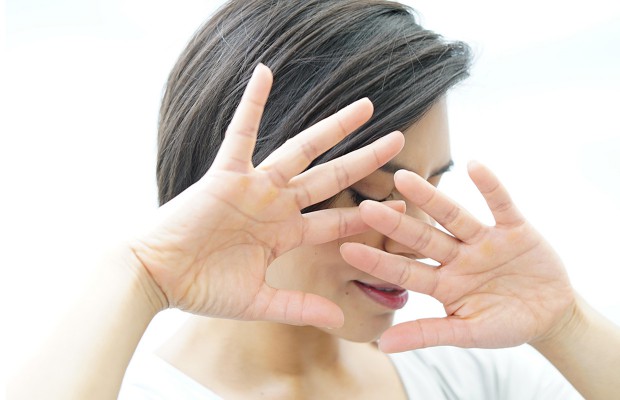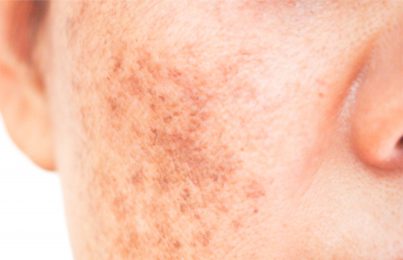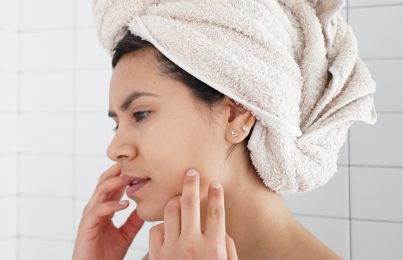Updated 05/15/22. So you just got a chemical peel. An esthetician or dermatologist applied an acid solution to your face to remove the top layers of skin along with any discolored cells. Eventually, the top layers will peel and flake away, revealing brighter, fresher, more youthful-looking skin underneath. Until then, though, you’re left with dryness, irritation, redness, and peeling, which are all perfectly common post-peel side effects. What can you do to manage these side effects and support your skin when it’s in this vulnerable state? Keep reading to learn how to care for your skin after a chemical peel!
Note: The suggestions I share in this post are for light to medium peels. These are the types of peels I perform and they’re the ones with which I have the most experience. The skincare professional who performed your peel should have given you detailed aftercare instructions. If not, you might want to consider contacting them since every peel (and skin type) is different.
How to Care for Your Skin After a Chemical Peel
Be Gentle With Your Skin
It’s so important to be very, very gentle when touching your skin after a chemical peel. Don’t use too much pressure when applying products and avoid any type of aggressive rubbing action. Some of the flaking cells will still be attached to live cells, and you don’t want to risk pulling those off when they’re not ready!
Be Extra Gentle When Your Skin Is Wet
Water melts and softens dead skin, so it’s very easy to rub off both dead and live cells when the skin is moist. Use an especially light touch when your skin is damp from cleansing or showering. And don’t use any type of washcloth or cleansing brush; it’s way too risky (but more on that in a minute).
Wear Sunscreen
This may be stating the obvious, but your skin is extremely vulnerable after a chemical peel. UV light, even if it’s a cloudy day outside, is damaging your skin. Make sure you’re protecting it with a good sunscreen formula. If your skin is super flaky, and you don’t want to touch it or rub it at all, consider using an SPF-infused powder. You can dust it on quickly and easily.
Limit Time Spent Outdoors
After a chemical peel, you want to hibernate as much as possible to keep your skin protected. Avoid exposing your skin to heat and UV light. It’s already in such an inflamed state, and you don’t want to make it worse.
Use Products With Soothing Ingredients
Provide as much comfort to your skin as possible to ease redness and irritation. I tell my clients to use a water-based gel mask (no more than once a day) if they feel like their skin is too uncomfortable. I suggest keeping it in the refrigerator to provide an extra cooling experience. I’ll either recommend the Bio Calm Repair Masque or the Rapid Response Detox Masque, depending on the client’s skin type. I will also have the client use a soothing moisturizer like the Phytolipid Comfort Creme.
Keep Your Skincare Routine Simple
If you’re wondering what to put on your face after a chemical peel, I recommend following this simple routine.
- Use a gentle, sulfate-free cleanser. The Renée Rouleau Moisture Protecting Cleanser is a great gel-to-milk formula that won’t leave the skin feeling dry.
- Mist an essence onto the skin. This is essentially the same thing as an alcohol-free toner, but it’s serum-infused for extra moisture. Normally, you’d apply it on a toning cloth and wipe it over the skin. To minimize rubbing and touching, though, you’ll want to put it in a spray bottle and mist it onto the skin. If you don’t have a spray bottle, pour it into the palm of your hand and gently pat it on the face. I recommend the Renée Rouleau Moisture Infusion Toner for this step. It deeply hydrates the skin and can be used year-round for skin types that need it.
- Apply a gentle vitamin C serum. After a chemical peel, free radical production is high. You’ll want to suppress some of that free radical activity with a gentle vitamin C serum. Plus, chemical peels can stimulate melanin activity and cause hyperpigmentation. A well-formulated vitamin C serum can help calm melanin cells. What you should know, though, is that many vitamin C serums use acid-based ingredients. You’ll want to avoid these and use serums with ingredients like Magnesium Ascorbyl Phosphate, Tetrahexyldecyl Ascorbate, Ascorbyl Methylsilanol Pectinate, or Ascorbyl Palmitate, instead. These are considered best for sensitive skin since they are stable, acid-free, and don’t cause a stinging sensation.
- Apply moisturizer. During the day, use a moisturizer with sunscreen. One with Zinc Oxide is ideal, as it will be more soothing to the skin. In the evening, use a non-sunscreen moisturizer that’s formulated for your skin type.
What Not to Do After a Chemical Peel
Don’t Pick or Pull at Your Skin
The whole purpose of a chemical peel is to lift away dry, damaged cells and reveal younger-looking cells underneath. But to do this, the skin has to shed. That’s the part that people dislike the most. It’s worth the wait, though. If you pick off dry, flaky skin that’s not ready to come off, it could cause scarring and unnecessary redness. It’s best to leave it alone!
Don’t Use a Washcloth, Facial Scrub, or Sonic Cleansing Brush
As mentioned above, dead, flaky skin softens when exposed to water. It can be very tempting to want to rub away that dryness with a washcloth, facial scrub, or sonic cleansing brush. Please don’t use any of these. Should any new cells come along with it (which they will!), you’ll wind up with scabs all over your face. I’ve seen it happen time and time again. This certainly defeats any benefits of getting the peel in the first place.
Don’t Use any Acid Ingredients
Just like how you shouldn’t use any physical exfoliants (washcloths, scrubs, or brushes), you should use any chemical exfoliants (acids and enzymes). You must let the skin shed naturally on its schedule. Acids and enzymes, whether in a cleanser, toner, serum, mask, or moisturizer, will only irritate the skin further and possibly burn and temporarily scar the skin.
Don’t Over-Moisturize
When the skin is peeling and flaky, it’s normal to want to continually apply face oil or heavy moisturizer to alleviate dryness. While it’s important to keep the skin moisturized, you don’t want to moisturize too much. After all, the whole purpose of a chemical peel is to PEEL. And the less rubbing, massaging, and tugging on the skin you do, the better.
Use a comforting moisturizer twice a day and let the skin do what it wants to do—shed. If you are going out and want to camouflage some of the flakiness, pat a few drops of face oil on the skin, like the Renée Rouealu Pro Remedy Oil.
Don’t Eat Highly Acidic Foods
When acidic foods like tomato sauce, oranges, and salsa touch the face, they can lower the pH of the skin and cause irritation. (Believe it or not, I’ve seen a lot of people get burns/rashes on the sides of their mouths after a chemical peel from eating pizza!)
When you get a chemical peel, your moisture barrier is very damaged and your skin acts extremely sensitive. Since the mouth area is the place where you’ll see the most peeling due to facial movements from talking and yawning, this area can be very reactive. It’s best to put a pause on eating acidic foods until your skin feels better.
Don’t Sweat Too Much
Especially at the height of peeling, your moisture barrier is very damaged. When you sweat while working out, the salt in your sweat can cause a stinging sensation which may further irritate your skin. I suggest doing low-impact workouts to minimize sweating during this time.
Don’t Use Retinol or Prescription Retinoids
These products stimulate cell turnover from deep within the skin. While this is normally great for the skin, it’s already happening after a chemical peel, and you don’t want to kick your skin into overdrive and cause more irritation. Just like with exfoliating acids, you’ll want to use these once your skin feels better, just not quite yet!
So there you have it. These are my best tips after over 30 years of experience giving and getting chemical peels!
Next, learn how you can give yourself a chemical peel at home.
Celebrity Esthetician & Skincare Expert
As an esthetician trained in cosmetic chemistry, Renée Rouleau has spent 35 years researching skin, educating her audience, and building an award-winning line of products. Her hands-on experience as an esthetician and trusted skin care expert has created a real-world solution — products that are formulated for nine different types of skin so your face will get exactly what it needs to look and feel its best. Trusted by celebrities, editors, bloggers, and skincare obsessives around the globe, her vast real-world knowledge and constant research are why Marie Claire calls her “the most passionate skin practitioner we know.”




Comments:
I had a deep phenol peel 4 days ago and I have a thick green substance stuck to my face. I was told that it’s fluid from cells, but it’s stuck like cement! I can’t get it off and was told to scrub hard with a washcloth until my face bleeds! My face is so tender, I can barely stand to touch it! What can I do to get this off my face?
Posted By: Katie |
I would not suggest scrubbing or rubbing your skin until it heals on its own from the peel. Rubbing the skin to the point of bleeding will very likely create facial scarring. I would suggest letting your body naturally heal. It is wise to skip all forms of exfoliation until your skin returns to normal. To help calm and soothe use a water-based hydrating mask like Bio Calm Repair Masque.
Posted By: Renée Rouleau |
Hi there,
Thanks for the articles..after a 2 months of my the second session my skin is still dry and small bumps here and there…which makes my skin look dull and uneven ( worser than before). Is it mean my skin is still healing or peeling did nt suit my skin ?
You opinion is highly appreciated..based on that I may have to plan for 2 more sessions.
I have gone into 1. Yellow peel 2. Glycolic 50 percentage +Innepal
Thanks,
Santhana
Posted By: Santhana |
Based on the information you shared with me it sounds like you are a great candidate for a My Skin Rx Virtual Consultation! The consultations connect you with an esthetician to help you one-on-one with your routine. You can learn more and book an appointment here.
Posted By: Ella Stevenson |
I did peeling on my face before ten days. But yet now not clear on my face. After peeling i have lots of scars on my face.so what should i do.please suggest me for this treatment.
Posted By: Smriti parikh |
I would suggest using a daily vitamin c serum, like the Vitamin C&E Treatment.
Posted By: Ella Stevenson |
I wish I read this three days ago. I had microneedling followed by a vitamin c peel by an esthetician who yielded great results with a couple of my friends. Unfortunately, after a steamy shower on day two, I used a washcloth and quite vigorously scrubbed peeling skin off of my face! I did it again this morning. My skin is very tight, appears hyper pigmented (I’m shade 4, naturally) in certain patches. I hope there is no permanent damage. I wasn’t provided post-care info, but I should have asked. Any recs at this point?
Posted By: Sia |
Hello,
I did my 3rd (every 2-3 weeks interval) obagi radiance peel 7 days ago. Although most of the peel had gone completely, there are still areas that are still intact. The sides of my my cheeks I’m not worried about as they are thicker and could see and feel the edges of them. What I’m worried about is my forehead, parts of it, mostly the top corners, are quite stubborn. I can see and feel the shine and their shade a tad darker, but they are almost like attached to the skin. Will they still come off? Will Clarisonic help yo remove them? I think they are dry already, it’s just that their sitting there and won’t budge.
I would greatly appreciate any response coming from you.
Thank you so much!
Nini
Posted By: Nini |
Hi! We never suggest picking at flaking skin or using a cleansing brush after a chemical peel as this can cause trauma to the skin and pigmentation. As frustrating as it may be, wait for the skin to naturally slough off. If you have any additional questions, we recommend speaking with the provider of the peel since they’re experts in that treatment and are familiar with your skin.
Posted By: Renée Rouleau |